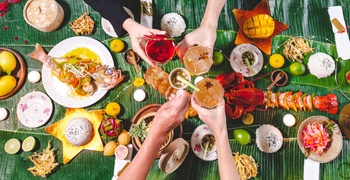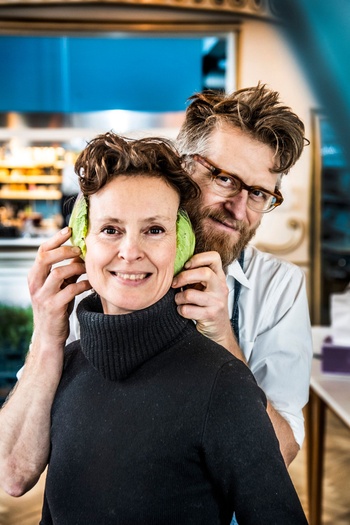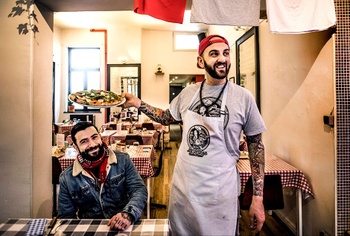In five years, the food scene in Brussels has changed a lot. It has become more sharing, more daring, and, above all, more environmentally conscious. Before being stopped dead in its tracks. Let's take a look in the rear-view mirror.
© Saskia Vanderstichele
| San Sablon.
On The Rise and Fall of Ziggy Stardust and the Spiders from Mars, David Bowie conjured up a terrible scenario: planet earth doomed to self-destruction within five years. The album opens with “Five Years”, a tragic hymn foretelling the terrible event. The rousing opening track ended with the “Thin White Duke” screaming “We've got five years, that's all we've got.”
It is impossible not to see a parallel with the situation facing restaurants and cafes today. What would those establishments have done five years ago if they had been told that, a few years later, they would be closed for a year? We are willing to bet that many of them would have stopped straight away and moved on to something else.
Such a disaster would have deprived us of half a decade of dynamic innovation. We look back on the key changes in a food scene that we hope will rise from its ashes. Eating is a form of cultural expression, just the same as music, theatre, literature, or the visual arts.
The Korean wave
It's an undeniable fact: in a succession of waves, Asia has arrived on our plates. Following China, Thailand, Vietnam, and Japan's total takeover, it is now time for Korean cuisine to have its moment in the spotlight. There is something paradoxical about its presence in Brussels. There has been no surge in establishments claiming to represent the Land of the Morning Calm. Apart from Maru, the pre-eminent establishment for lovers of Korean food, there are only a few examples, although Bap & Dak in Elsene/Ixelles caused a big stir just before the forced closure of the entire sector.
No, the “Korean craze”, as they call it in New York, a city that was completely taken by storm by this wave, has spread in a more subtle way in our capital. Seoul has conquered Brussels through the spread of the characteristic flavours of lactic acid found, for example, in kimchi. Kimchi, which consists of fermented vegetables mixed with seasoning, is without a doubt the dish that spearheaded the trend. This speciality, miles away from anything we are used to, has carved out a place for itself in our culinary imaginations. It is found in many organic food shops – including a local version, “Zenne Kimchi” by Itinéraire Bis Gourmand, a duo of producers who make it with Chinese cabbage grown in the Zenne/Senne valley – and on the menu in some excellent restaurants, which reinvent it as they like. In addition to kimchi, San Sablon pushes the boundaries further with “jangajji”, which is made by marinating vegetables in water, soy sauce, sugar, and vinegar.
In this age of coworking, a participatory economy, and intersectionality, food had to move with the times

Sharing plates
Nowadays, restaurants are expected to be “experiential”, a term that expands on the notion of the restaurant envisioned in the 2000s as a place of relaxation. The concept of “eatertainment” has also emerged: dishes that are shared between diners set the tone for a new culinary paradigm. The origins of the trend can, of course, be traced directly to certain cuisines from around the world – Spain (tapas), Morocco (kemias), Greece (mezze) – in which a culture of spending time together is part of their DNA.
There are two sides to this phenomenon. On the plus side, the plate-sharing gimmick makes sense. It was the brainchild of people who recognised the collaborative spirit of our era. In this age of coworking, a participatory economy, intersectionality, etc., food had to move with the times. The approach also entails an environmentally sound use of food, which is not dissimilar to the move from individually packaged products to loose goods.
The only drawback, the “dark side” of “sharing food”, is that a dish-sharing pipeline has emerged in the restaurant trade; some companies deliver them turnkey to restaurants. Rather than being a practical approach, therefore, it then merely serves to reinforce consumers' most selfish impulses, turning them into tyrants. There is an element of “everything being available at all times” in this formula. One place in Brussels appears to be above such suspicion: Humphrey. With the tagline “sharing plate experience”, they have come up with many participative gimmicks, such as serving entire products (a Mechelen chicken cooked at a low temperature, a cobia fish with the skin and fins intact, etc.) and letting the diners figure out for themselves how to share it. Or, yet more disconcerting, serving three or five courgette fritters on a plate for… four people. “Sharing is above all re-learning how to communicate, to exchange…rather than eating in deathly silence,” explain Julie De Block and Glen Ramaekers, the owners.

© Saskia Vanderstichele
| Nicolas Decloedt en Caroline Baerten van Humus x Hortense.
The rise of the vegetable
We had to think for a moment before deciding between the rise of vegetables and that of…meat. No matter how much the environmental crisis is hammered home every day, meat-based establishments, burger joints etc., continue to appear in Brussels. On closer inspection, however, it is nonetheless with vegetables, which were previously given outsider status in most dishes, that the most impressive progress has been made. That progress is measured less by the number of vegetable-centred establishments and more by the formidable leap in the quality of what chefs create from vegetable-based ingredients.
To give credit where credit is due, Nicolas Decloedt and Caroline Baerten set an extremely high standard for the vegetable patch with Humus x Hortense. The couple put their heart and soul into creating beautiful dishes using vegetables supplied, for example, by the market gardener Dries Delanote in Ypres, opening our eyes to little-known treasures such as yacon (a poire de terre, “pear of the earth”) and purple salsify.
The same enthusiasm can be seen in other projects. Pascal Devalkeneer, the chef at Le Chalet de la Forêt enlisted the landscape architect Erik Dhont to design an attractive urban vegetable patch on the edge of the Zoniënwoud/Forêt de Soignes. Far from merely decorative, the garden provides all the herbs and just over a third of the vegetables used by the restaurant. In a more humble but equally exciting venture, Bel Mundo, the restaurant of the non-profit organisation Atelier Groot Eiland, grows its vegetables in a 1.500 m² vegetable patch located at the back of the building where the restaurant has made its home.
For a long time, pizzas in Brussels resembled the cardboard they were delivered in. That culinary nightmare ended not long ago

© Saskia Vanderstichele
| La Bottega Della Pizza.
Sourdough is in
For a long time, pizzas in Brussels resembled the cardboard they were delivered in. That culinary nightmare ended not long ago, when the capital discovered sourdough pizza. One of the pioneers was Nona, an excellent place that made its name serving wonderful pizzas made with their own flawless dough; fine, pleasantly soft in the centre and chewier around the edges. Another was Roberto Casula's magnificent project, La Bottega della Pizza. We can still taste his “tonno e cipolla”, a white pizza made with fior di latte, Calabrian red onions, and fresh red tuna sliced into sashimi.
We have lost count of the places that have joined the trend: Pasta Madre on Rouppeplein/Place Rouppe, Marcella at the end of Baljuwstraat/Rue du Bailly, Ciaooo in Schaarbeek/Schaerbeek, Basils a stone's throw from the Congress Column, and Educazione Napoletana in Elsene/Ixelles.
Viticultural naturalism
Aside from the question of whether people should be observing the measures to prevent the spread of Covid, there is one subject that is guaranteed to get a good argument going among friends: wine. Although the schism between adherents of natural wine and proponents of “vin de papa” is nothing new, it has intensified over the past five years to the extent that an insurmountable divide has emerged between the two camps.
Although the schism between adherents of natural wine and proponents of “vin de papa” is nothing new, it has intensified over the past five years
In case you are not familiar with the debate, “Vin de papa” is wine made by “people who know what wine is”, in other words, a drink that is “woody, with notes of vanilla, full-bodied, rich in flavour, alcohol, and texture”, according to the author and blogger Ophélie Neiman. In the other camp, the “naturalists” propose a vision of an open and evolving drink, whose taste is constantly being reinvented and questioned. Natural wine is a TAZ (Temporary Autonomous Zone), a space that the US writer Hakim Bey described as a territory that is “more free, festive, and united” all at once.
All evidence suggests that the people of Brussels have chosen which side they are on. It is clear from the large number of places (wine merchants, bars, and restaurants) that have opened which celebrate wine that is free from chemical additives. Examples include Cave Coop (Elsene/Ixelles), Nabu (Sint-Lambrechts-Woluwe/Woluwe-Saint-Lambert), Chez Jane and Chez Tarzan (Elsene/Ixelles), Rebel (Elsene/Ixelles), Calmos (Sint-Gillis/Saint-Gilles), Titulus (Elsene/Ixelles), Chez Félix (Schaarbeek/Schaerbeek), Winery (Bosvoorde/Boitsfort, Elsene/Ixelles), Le Citron Poilu (Elsene/Ixelles), and many others.
Read more about: Resto & Bar